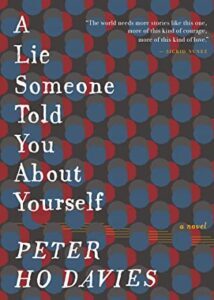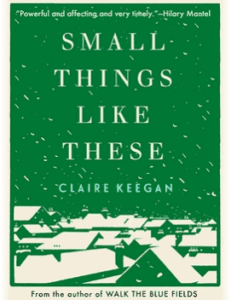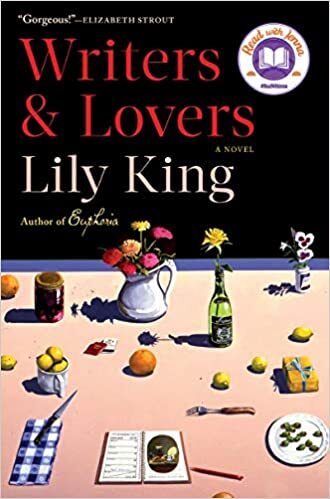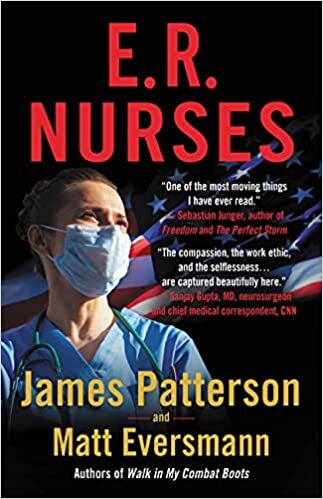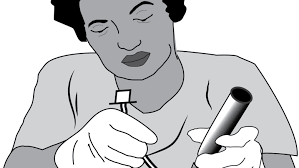Elizabeth A. Havey's Blog, page 5
March 6, 2022
A Portrait of Fatherhood: A Lie Someone Told You About Yourself by Peter Ho Davies
The word maternity immediately provides an image of a pregnant woman, a would-be mother, the female aspect of reproduction. But it takes two to tango, and in English author Peter Ho Davies new novel, the stress, worry and angst of welcoming a child into the world is seen specifically from the point of view of the father. And in this case, there is marriage, there is love and there is desire for progeny.
But even so, in a time period when the male gender often walks onto the stage with strong opinions about pregnancy, birth and everything a woman expriences, this is a welcoming look at the role of a father. He may have opinions, but this is HIS wife and the fertilized embryo also belongs to HIM—and thus the burden of decision-making moves away from this is how it should be, I’m a guy, I know better… to Ho Davies and his emotional journey when his wife is pregnant and the doctors are not sure that things are going as planned.
The title page of the book asks us to immediately approach this story with open minds. “In abortion the person who is massacred, physically and morally, is the woman. For any man with a conscience every abortion is a moral ordeal that leaves a mark, but… every male should bite his tongue three times before speaking about such things.” Italo Calvino, author of Italian Folktales.
So if this is the title page, we can guess where we might be headed. And when Ho Davies is asked to talk about this, his answer: I think it speaks to the possibility that there must be some space for men to be allies of a woman’s right to choose, and how do we speak into that space…Calvino speaks to my own anxieties…
CHANCE: THE FIRST SECTION OF THE NOVEL
There is so much to say about this beautiful book. Ho Davies never names his characters, tells us “He was a writer now, this father, but had studied physics once,” thus offering the reader words like mosaicism, meiosis, words that were offered to the father: “Calling one thing something else, something safer.” He begins to bargain with himself–words are everything, so he and his wife could say, “We had a miscarriage.” Then he tells us: “The medical term for miscarriage is spontaneous abortion.”
He also tells us: Cars with pro-life stickers were everywhere on the roads that election year. When during that time he caught his wife buying Lotto tickets, he writes: they laughed until they cried.
His wife gets pregnant again. She never had morning sickness before; now she throws up before every test…A boy this time…They put the ultrasound in an envelope in a drawer in a desk. They don’t discuss names…when a friend asks why she’s not drinking, his wife says, If I told you, I’d have to kill you.
The doctor wants to do AN ULTRASOUND of the baby’s BRAIN! They pace the halls, the wife in a wheelchair–and the doctors return, smiling: Oh, the baby is fine. It’s nothing. The test just precautionary.
READING ON: Section 2 TAILS Section 3 HEADS TWICE
Once you are on this journey with this family, you can’t stop. The writing is honest and relatable. There is hope and love, there is fear and worry. One teacher suggests “the boy” has autism. As with anyone who has ever had a child there is THE FIRST TIME: how he walks, when he starts school, Ho Davies teaching, his wife also working, their son the center of their universe. They are good people, they are great parents. And criticism whether self-imposed or from others is a lie.
When the boy is in school, the father finds time to volunteer at Planned Parenthood. Ho Davies writes: Later he will understand that he’s not been at the clinic to do good, or even to get material (for this book), so much as to find absolution.
FINAL THOUGHTS
I don’t think there are many books written by men, that reveal so much fear and angst, yet so much understanding and love, perils and joys that humanity experiences when they decide or they don’t decide, but find themselves to be: parents. Though he doesn’t name his characters (they are He, She, the father, the mother, the boy) we are with them through all their worries and trials. We are routing for the the boy as he starts school, makes mistakes, tries his best–as his parents put alway all of their fears and become fierce lovers of this son they have created.
PS And the title: “Shame is the lie someone told you about yourself,” according to writer and thinker, Anais Nin.
Facebook Twitter LinkedInPinterestFebruary 27, 2022
THE GIRL WHO COULD BREATHE UNDER WATER
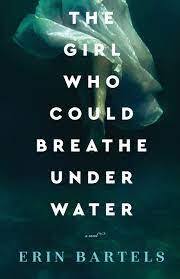 Writers are fueled by many things: love of language, an eagerness to explore ideas and themes, the belief that well-wrought characters and a dexterity with words will speak to others, and maybe even change the world.
Writers are fueled by many things: love of language, an eagerness to explore ideas and themes, the belief that well-wrought characters and a dexterity with words will speak to others, and maybe even change the world.
Erin Bartels, author of three previous novels and a collection of short stories, brings to her fiction the love of history and place, strong personal beliefs, as well as beautifully crafted language. But in this, her latest novel, Bartels probes the very act of producing fiction, of looking back on one’s life, of allowing painful experience to form plot and story.
Channeling memory, Bartels attributes a similar past experience to her main character, Kendra, also a novelist, who when the novel begins is staying in a summer house on a lake in upstate Michigan. Kendra’s grandfather has recently died, her mother is estranged–the cabin on the lake providing a perfect place and time for Kendra to focus, finish her current novel.
At its beginning, THE GIRL WHO COULD BREATHE UNDER WATER acknowledges the words of F. Scott Fitzgerald:
For those I’ve failed and those I’ve forgiven All good writing is swimming under water and holding your breath. F. Scott Fitzgerald
WRITING THAT NOVEL
Kendra knows the trajectory of her story, she just needs to tie up some loose themes, write the ending. But writer’s block has set in, she now struggling with the words in a letter concerning her last novel, a letter signed by A Very Disappointed Reader. (an excerpt) Kendra, Your book, while perhaps thought “brave” in some circles, is anything but. It is the work of a selfish opportunist who was all too ready to monetize the suffering of others. Did you ever consider that antagonists have stories of their own? Or that in someone else’s story you’re the antagonist?
It probably wouldn’t have mattered what the letter said, but it does matter who wrote the letter. And t his quest becomes the engine for the novel. Who wrote the letter and why. Who wants to hurt Kendra, to increase her doubts about her writing, her purpose in life, the pain that made her write novels in the first place. Being an author has saved her from an absent mother and other secrets of the past. Being able to write parts of her story has healed wounds.
Though readers of The Girl Who Could Breathe Under Water are not privy to exact passages from the novel within the novel, we begin to see that this initial letter that is unsigned will haunt Kendra all summer, while she works on her newest book, takes up a friendship with a man who speaks fluent German and is translating her first novel into that language.
Now older and successful, because of that first novel, Kendra has come back to this place of memories. She is eager to work and also enjoy the lake of her childhood. But the words of the Very Disappointed Reader haunt.
“the admiration of strangers is all you’re likely to get…It certainly won’t win you any new friends. And I’m willing to bet the old ones will steer pretty clear of you from here on out. In fact, some of them you’ll never see again.”
Such words become worse than writer’s block. They prevent healing and encourage Kendra to push the memory down “under water,” she being afraid to look at it, examine it and its eternal effect on her.
If Hidden Lake is a trigger, than what Kendra needs to deal with must involve the people who have also returned for the summer. In the light of sunshine and birdsong, will Kendra be able to heal, stop pushing the memory “under water”, stop holding her breath? Maybe those who return to the lake are also connected to some “hidden” past.
POETRY, PROSE and STYLE
Bartels’ writing soars, some sentences moving toward poetry.
In all our enchanted summers together on the lake, there had been more good than bad. Sweet silent morning. Long languid days. Crisp starry nights. Your brother had thrown it all out of whack, like an invasive species unleashed upon what had been a perfectly balanced ecosystem. But he hadn’t destroyed it. The good was still there, in sheltered pockets of memory I could access if I concentrated.
The novel can jolt a bit, Bartels often referring to You, as if this is a story for someone else, we are only being allowed to learn of the events. It’s a stylistic device that eventually works–the YOU is Kendra’s childhood friend Cami, who is not at the lake, who has disappeared. Her brother is definitely there: (Tyler would be there. Every paradise needed a serpent.) and thus we sense Kendra wants little to do with him. Once the reader adjusts to this methodology, the flow of the novel is clearer.
It was apparent that she didn’t know that you and I hadn’t talked in eight years. That you had never told your mother about the fight we’d had, the things we’d said to each other, the ambiguous state in which we’d left our friendship. And now a woman who only talked to me when necessary was reaching out, wondering if I knew how to get in touch with you. That was the day I started planning my return to the intoxicating place where I had spent every half-naked summer of my youth—because I was sure that in order to recover you, I needed to recover us.
HIGHLIGHTS FROM THE NOVEL
…I was lying to myself about why I decided to finally return to Hidden Lake. Which makes perfect sense in hindsight. After all, novelists are liars.
But you know what it’s like when someone attacks your writing. Criticize me about anything else – what I look like, what I drive, what my ancestors did to your ancestors- who cares? But my writing, your writing…that’s the real you, isn’t it? That’s what is inside of you. To have it thrown back in your face is just the worst feeling in the world.
All fiction is based in reality. That’s why we read it. That’s why we write it. To process reality. To deal with all the crap that happens to us.
The best fiction simply tells the truth.
But the truth is never simple.
FROM AN INTERVIEW WITH ERIN BARTELS
Your main character is an author who wrote a novel based on her own experiences. Is any of your novel based on your experience?
Yes, though certainly not all of it. The emotions in this story are ones I’ve been working to process for more than three quarters of my life, and there are a few scenes that I wrote almost exactly as I remember them happening to me. But most of the story is simply extrapolated from my own experience and the experiences of a lot of women. I think every woman who reads this book will find herself somewhere within the pages.
Novels are about looking through someone else’s eyes, seeing what someone else sees when they look at the world, and realizing, perhaps for the first time, that other people are just as real and alive and hurt as you are. Erin Bartels

Erin Bartels
Facebook Twitter LinkedInPinterestFebruary 20, 2022
George Harrison’s Garden
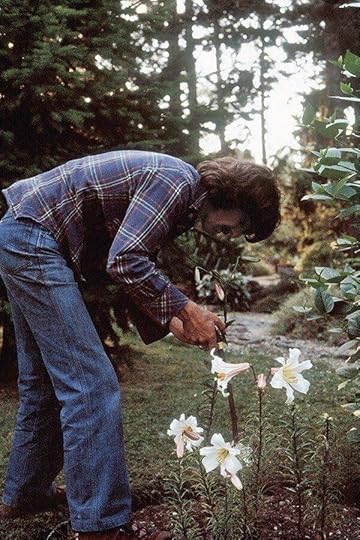
People can surprise us. When we hear the names of famous people: writers, politicians, scientists, musicians etc we picture them in the category where they are most known. But human beings are various, they can surprise you. When someone who has “made it” turns to a charity and makes that the focus of his or her life, WOW. That’s a surprising, thrilling choice, the “not the every famous person writes a book choice!!” We see the variety of human connection. We see this person not as a NAME, but as someone that just might be a little bit like us.
CREATIVITY
George Harrison? Music, Beatle, famous, rich–all those labels come to mind. So what about GARDENER? I love to garden, have written about that forever. On a warm day, with the sun on my back, I love digging in the dirt. It turns out, Harrison did too, though at a greater, more expansive level. After all, he was a Beatle! And so he purchased Friar Park, a Victorian neo-Gothic mansion in Henley-on-Thames, England. The magnificent house and surrounding gardens was built in 1889 and originally owned by eccentric lawyer Sir Frank Crisp. Harrison purchased the property in January 1970 when he was still a member of the The Beatles. The site consists of 62 acres–that’s a lot of gardening.
GEORGE HARRISON, His Spiritual Side
Harrison became fascinated with meditation and eastern music. He taught himself the sitar, and introduced it to popular American and British music in John Lennon’s song, “Norwegian Wood.” He created a close relationship with renowned sitar player Ravi Shankar. Other rock groups took notice and began also incorporating the sitar into their compositions. In some ways, Harrison’s creativity helped form the ground-breaking Beatles albums, including Revolver and Sgt. Pepper’s Lonely Hearts Club Band.
My brother, who has followed the Beatles since their very first song arrived in the America, comments: “It is pretty amazing that George shed all of his notoriety, to go and “hide” behind the walls of Friar Park, to get close to nature. He did have a small recording studio built in one of the buildings, where he wrote songs and recorded music. But they say these days were some of his happiest.
THE SOUL AND THE GARDEN
I can’t begin to know what George Harrison felt when walking the grounds of his magnificent home, but I can try to step into his shoes when he might have gone off by himself. Hopefully, he had a basket of tools, a pad to kneel on, the sun on his back, maybe a good pair of gardening gloves to DIG IN THE DIRT. Maybe he listened to music while he spent his time in nature. Maybe he created tunes in his head, later grabbing a guitar or sheet music to write them down.
I do know in his last years his smoking caught up with him and he developed throat cancer. Eventually the cancer went to his brain and he died. George might have been known as the quiet Beatle, but we all have those moments when silence is what we need: to think, to create, to maybe hum a tune that we later pick out on a piano. Basically, we all need time to be WITH OURSELVES, to block out the noise, the constant hum of living. Because when we DIG IN THE DIRT or go off to sit with a song, we are feeding our spiritual side. George Harrison new how to do that. His music reflects that choice. (This post is dedicated to my brother Bill, who is a faithful reader. Thanks, Bill.)
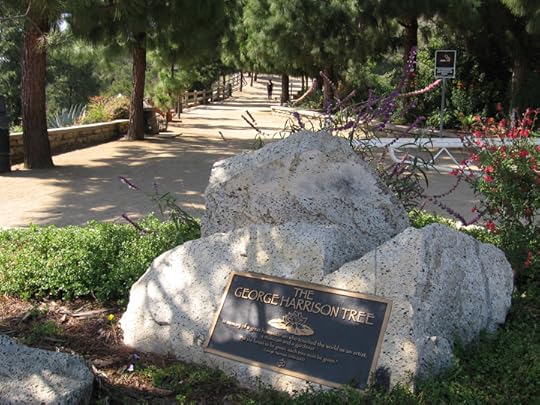
Memorial to George
Facebook Twitter LinkedInPinterestFebruary 13, 2022
Novel: Small Things Like These

Magadalen Laundry
This lovely novel (116 pages of beauty and sorrow) uses lilting language to gradually lead us to a message that the reader knows is coming. After all, Claire Keegan is Irish, the flow of her words carrying me across the Atlantic on the very first page.“In October there were yellow trees. Then the clocks went back an hour and the long November winds came in and blew, stripped the trees bare….Down in the yard, Bill Furlong, the coal and timber merchant, rubbed his hands, saying if things carried on as they were, they would soon need a new set of tires for the lorry.”Yes, a new set of tires, but possibly a new set of beliefs. Driving wears down tires. Living can wear down youth, hope; it can shatter what for centuries some believed to be true: that the dark clothing worn by nuns enclosed them in piety, prayerfulness. That their virginity was a sacrifice to God, setting them apart from those in town who pushed out one baby after another. Like Bill Furlong’s wife, Eileen, mother of five daughters.Even in a place of quaintness and kindness, tradition and prayer, there is sadness, downright depravity. It can sneak up on you, come from the strangest of places, like the immaculately kept, beautifully landscaped building on the hill at the end of the town, its many windows covered with dark iron grills.
“At some point later, an upstairs curtain moved, and a child looked out.”
HISTORY and LITERATURE
Why read this novel, if you pick it up, see the dedication: Th is story is dedicated to the women and children who suffered time in Ireland’s mother and baby homes and Magdalene laundries.
YOU READ IT, because a writer’s purpose and the purpose of much literature it to take you there, enlighten you. “As soon as he forced this bolt, he sensed something within but many a dog he’d found in a coal shed with no decent place to lie. …When he shone his torch on what was there, he judged, by what was on the floor, that the girl within had been there for longer then the night. ‘Christ,’ he said.”
CHARACTERS REACH US
In this novel, we learn that Bill Furlong was adopted. And over time, we see that though he loves his wife and five daughters, he is often drawn back to the mystery of his beginnings. He reaches out to us, the writer’s strength being her ability to create a character so affecting.
“Crossing the bridge, he looked down at the river, at the water flowing past. People said a curse had been placed on the Barrow. Furlong couldn’t remember the half of it but it had to do with an order of monks who’d built an abbey there, in the old days, and were given the right to levy tolls on the river…the people had rebelled and driven them from the town. When they were leaving, the abbot put a curse on the town…every year it would take three lives…”
NO SMALL THING TO BE A HERO
Bill Furlong works hard, driving his lorry through his and nearby villages to deliver coal and wood to keep people warm during harsh Irish winters. Bill Furlong will get home in time to attend Christmas Eve services with his wife and daughters. But as he drives through the darkening land he knows so well, he becomes the hero of this lovely story, his own blessing, his own gift. My recommendation: read this and other works by Claire Keegan
Facebook Twitter LinkedInPinterestFebruary 6, 2022
Mini Review: Writers and Lovers
I’m a writer. I write fiction. I am also a woman.
In Lily King’s WRITERS AND LOVERS, her MC, Casey Peabody, has certainly had more lovers than I, but her novel is a song to me, a beautifully written story of a woman’s search for love–the love of a man, the love and sorrow of missing and losing her dead mother, but most importantly, the love of writing.
With language that is carefully wrought and filled with reality, King takes us on Casey’s journey of struggle. She’s working as a waitress in Boston. She’s living in a shed, and when the opportunity presents itself, she is writing her novel. Casey is also searching for love, and consistently finds it in the wrong places.
But that’s her story–WRITERS AND LOVERS. King brings us close to the heartbeat of creativity, as well as the heartbeat of loss and pain. We might shake our heads at some of the men Casey falls for–yet all along we are cheering her on, because deep within her is the truest love of all–her love of creativity, of writing, of putting on the page the LIFE she is living and the WORLD she inhabits. Beautifully wrought, this novel requires marking memorable passages, clinging to the movement of the story. Bravo, Lily and brave Casey for the final decision you make!
EXCERPTS To support my review, I have chosen some lines and passages from this lovely novel. Happy Reading.
I feel the memory fall through my body like a stone.
When people have babies they stop calling you back.
It’s a particular kind of pleasure, of intimacy, loving a book with someone.
I am wasting my life, I am wasting my life. It pounds like a heartbeat.
The hardest thing about writing is getting in every day, breaking through the membrane.
(her mother says to Casey) “Tomorrow after you leave, I will stand here at the window and remember yesterday you were right here with me.”
People die when they go on trips.
(a comment made while looking at a painting by Singer Sargent: There’s madness to beauty when you stumble on it like that.
You don’t realize how much effort you’ve put into covering things up until you try to dig them out.
The panic feels loud as hell in my head….Something eases and aches in my head at the same time.
I can’t stay still. But I’m scared to leave. I don’t want to walk down the driveway and out to the street, I’m scared I won’t come back. I’m scared I’ll burst or dissolve or veer straight into traffic. I’m scared of men in cars and men in doorways, men in groups and men alone. They are menacing. Men-acing. Men-dacious. Med-tal. …They justify everything their dicks make them do.
Being around kids means thinking a whole lot of things you can’t say.
(scattering her mother’s ashes) I don’t allow myself to believe that my mother’s body–her hair, her smile, the two chords that made the sound of her voice, her heart, her good bum, her moisturized legs, her toes that tinkled when she walked–has been burned down to this rubble in my hand.
Facebook Twitter LinkedInPinterest
January 30, 2022
E.R. Nurses: by James Patterson & Matt Eversmann
I have always been fascinated by science and medicine, so much so that after my children were born and my youngest was ready to spend mornings with other children at daycare, I went back to school, studied and became a Registered Nurse. During my last semester, I did what is called an Externship. I worked on medical-surgical units to get more experience.
As my graduation drew near, the nurse recruiter urged me to apply for a position in one of those units. I thanked her, stressing that I wanted to work in Maternal-Child. She smiled, said there was no way anyone would hire me right out of nursing school. But s he was wrong. All along I had been reading Nursing Journals, studying the lists of available positions when they were listed. Just before my graduation, it was right there waiting for me, openings in Maternal Child at Mercy Hospital.
I applied, did an interview and secured a position, the hospital in downtown Chicago, a commute I could manage. There were other new recruits that started with me, some having chosen different specialties. Mercy spent 14 days orienting us to hospital policy, the layout of the hospital and specifics as to how the different departments functioned. Then we were tested, and that took another two weeks, before we were assigned and dismissed to our units.
WORKING WITH A PRACTICED RN
The first day, I met my preceptor, Julie, an experienced nurse who guided my every move, provided encouragement when I had to start my first IV, learn how to interpret fetal monitoring strips, perform internal exams, and eventually work in the delivery room as both a scrub or circulating nurse. Julie was honest and encouraging, practiced and patient. Mercy was a tertiary care center at that time, a teaching hospitals for doctors, so we also learned how to work with interns and residents, who were often just as nervous and uncertain as we were.
SCUT WORK AND ARGUMENTS
My time in Labor and Delivery had its rewarding moments and its stressful shifts, an intern complaining I hadn’t responded as quickly as he wanted, an argument with a resident about a patient’s temperature, which he wanted to ignore, but I knew indicated a serious change in the patient’s condition. He finally listened, called his attending. But I wouldn’t change any of it.
And when I wasn’t working the 3-11 shift, I made sure I watched every episode of ER!
SO MANY OF US ARE FASCINATED
Medicine and the work of saving a life, bringing a baby into the world, fighting a stubborn disease, saving a patient from a bullet wound, broken bones or a devastating disease has always been of interest to writers, actors and the people that read or watch the distillation of how hospitals, science and medicine are part of the drama of life.
Think: Chicago Hope, Chicago Med, ER, Grey’s Anatomy (based on a major textbook that physicians read in medical school), The Resident, New Amsterdam, The Good Doctor, St. Elsewhere, Private Practive–to name a few. (I’ve watched them all!) Now James Patterson, author of more than 200 novels, recently published a book honoring nurses. He partnered with Matt Eversmann, a retired army vet, who also worked with Patterson writing, WALK IN MY COMBAT BOOTS.
The book is entitled: E.R. NURSES and is divided into DAY SHIFT, NIGHT SHIFT, FLIGHT SHIFT and THANK YOU. The two authors interviewed nurses from across the country, nurses who often started in different jobs or positions, some in healthcare, but finally found that the desire to save lives was the most rewarding path they could follow.
Liz Martinez: They perform a thoracotomy, which is where you cut open the patient’s chest on the left side to gain rapid access the heart. It’s done only in a dire situation—it’s a heroic medical Hail Mary.
Kellie Travers: And if it’s a full moon? We’re flooded with crazy people and women in labor. (This is true!)
Andrew Festa: I want to give my patients hope. “Every case is different, so it’s difficult to say.” We had to put him on a vent. He dies later that evening. Sometimes hope is all we have.
Honna Vanhoozier: The great thing about nursing is that when your shift is over, you don’t take home anything physical. I don’t have reports or files or, like teachers, papers to grade. When I leave, I don’t think or dwell on things that happened that day…If something really bad happens, I talk with my work friends, who are like counselors. I can bounce things off them because they understand, and then after a couple of day, I move on.
Claire: I think about the man who committed suicide and the young woman who was brutally raped; of the patients who have died. Dealing with loss and tragedy day after day–I know it won’t get any easier no matter how long I do this work. There will always be cases that will get me because this is an emotional job. But this woman who just thanked me–it’s moments like these that make me and other nurses do what we do. We all want to make a difference for someone who needs it.
Thanks for reading. Please comment if you have had an experience with a nurse that you would like to share. Hopefully, it will be a positive one.
Facebook Twitter LinkedInPinterest
A Poem, During This Time of Covid
As a former RN and health educator, this piece struck me. I had to share it. It’s a bold piece of writing. It’s a warning. It’s medical. For some readers, it’s amazing. So, hang on.
And if this is too intense, hug a loved one, wear a mask and please get vaccinated or get your booster.
Written by Laura Kolbe She is an American poet whose debut collection, “Little Pharma” was published by the Universality of Pittsburg Press. 2021 This was Published in the New York Times
NOTE: History and Etymology for abecedary; Noun Middle English abscedary, borrowed from Medieval Latin abecedārium “alphabet, primer,” derived from neuter of Late Latin abecedārius “alphabetical,” from the names of the letters a + b + c + d + Latin -ārius
BURIED ABECEDARY for INTENSIVE CARE
It’s called an awakening trial when the pleasanter drugs stop.
It’s called bucking when the lungs and vent jam wing against each other.
It’s called clubbing when the fingernails thicken to spoons from lack of oxygen.
It’s called drug fever when no one knows why.
It’s called elevation when the eyes can see where the feet should be.
It’s called fasting when radiology foretells like a speaking goat on the blood-blue mountain.
It’s called gunk when they suction the trach.
It’s called hipaa when no one tells.
It’s called inspiration just before the triggered cough.
It’s called jaw thrust when the head is prepared for the macintosh blade.
It’s called kin when they don’t shy speechless from the gunk.
And when they do, it’s called labored when breath outmoans machines.
It’s called manual blood pressure when you hope the machine lied.
It’s called nitroprusside when the body is flushed like a cinema.
It’s called octreotide when the blood untucks the napkin of the diner.
It’s called a pan scan when the body won’t tell.
It’s called a query when the insurer and the bank won’t tell.
Called resuscitation but it isn’t.
Called shock when it started as resuscitation.
Called trendelenburg when the feet are in the air.
Called underventilation when the gas is more like the future planet’s.
Called the vagus nerve when touching the neck makes the rhythm stop.
Called weaning when the fentanyl hangs salivary at the chin of the bed.
Called xeroform when the gauze smells like gin and tonic.
Called you when it’s a question of error.
Called zeroing out when they reset the machines for the next body.
THANKS FOR READING, Please Wear a Mask and Get Vaccinated.
Facebook Twitter LinkedInPinterestJanuary 23, 2022
What to Wear to the Revolution….Looking Back
Elizabeth from Knoxville Tennessee chose a piano scarf to highlight her frightened, tear-streaked face when she was stopped outside the United States Capitol this last Wednesday, January 6th, 2021. “Yeah!” she told a reporter who stopped her as she ran from the scene: “I made it like a foot inside and they pushed me out, and they maced me.”
In the falling temperatures of that moment, the sky over the United States of America darkening, clouds and crowds gathering for the tempest, Elizabeth from Knoxville was trying to figure out why she was there at all. It had not gone her way. What next? But she cried out: “We’re storming the Capitol! It’s a revolution.”
But the interested reporter was soon swept away by the crowds of people, eagerly running from the Capitol. And so is Elizabeth from Knoxville, though she might be trying to find the food court at the revolution. (Not my whimsy, but that of another writer). Anyone who watched this quick clip that was widely broadcast must see it as the metaphor for craziness that currently grips our country.
MORE IRONY
I had planned to post about “differentiation– a theory of family therapist, Murray Bowen, who created the term, describing the process of finding a balance between autonomy (being a separate YOU) and connection (being with OTHERS) while creating goals and working toward them. Or to make it simpler: the concept that within a family each child can achieve emotional maturity by becoming his or her own person, able to form healthy relationships.
But Elizabeth from Knoxville had not considered differentiation, or may I point out USING HER OWN BRAIN. She had drunk the Kool Aid, she had traveled to be part of the group, the mass, the revolution. She believed that within the mob, there was glory. This was better than fulfilling a homework assignment. This was better than a vacation. THIS WAS the 6th of JANUARY, when all crazy people would triumph for trump.
Oh, and Elizabeth in her piano scarf did have a goal, the goal of the group–destruction. But sadly, she was running AWAY from the scene, without a statue or a portrait, or the head of one of the congress members.
And yes, maybe as she fled, she might have been singing one of the platitudes about a NEW GOVERNMENT, the GLORIOUS government of trump. MAKE IT PERMANENT. Because for Elizabeth of Knoxville, who probably never read her Social Studies book, or cheated on the exam, she had been reborn into a new way of thinking:
“it’s easy, guys. You get in a car or on a plane and go to DC and a whole new life will be laid out before you. It’s a REVOLUTION!! Let’s make trump king.”
AND FORGET HISTORY
So they wanted to create a different government, a trump government. But MY GOD, this country did start with a revolution, and then for hundreds of years used judgment, research, the arguing of ideas to keep the heat off. (And yes there was the Civil War) But do we need this???
Elizabeth, back in Knoxville, decided, along with many other crazies, that a romp at the CAPITOL was all that was needed to change things. Maybe the phrase Civil War only related to some dusty books or an old film like GONE WITH THE WIND. Today is today and we are going to make a permanent change with our mob mentality. We are going for it. How ironic. Oh, and when I first saw this clip, I tweeted that possibly she got really really angry when given a certain homework assignment. After all, that’s limiting her freedom. Time to grab that piano scarf and start a revolution.
FINAL THOUGHTS
So forgive my going off script today. But if you are full of doubt, if you have a family member who doesn’t want to listen to you or you don’t want to listen to them, maybe this questionnair created by differentiation guru Murray Bowen will help.
Which of Bowen’s statements, defining self-differenciation, applies to you or your children or grandchildren?
I understand the position I hold in my family, and the power given and not given to that position.I am committed to be fully responsible for my own life, while committed to those I love.In developing autonomy, I set goals for my dreams and ambitions, yet develop intimacy by allowing those close to me to see and know me as I really am.I can tell people what I need, ask for help, but not impose my needs upon them.I am able to detect when controlling emotions and reactive behavior have sent me in the wrong direction; then I opt, instead, to use creative thinking to make better and more purposeful choices.THANKS FOR READING This post first appeared in on Jan. 16th, 2021 Thanks to Hunter Walker for the photo. God Bless the United States of America.
Facebook Twitter LinkedInPinterestJanuary 16, 2022
Awakening: An Artist’s Sexual Visions
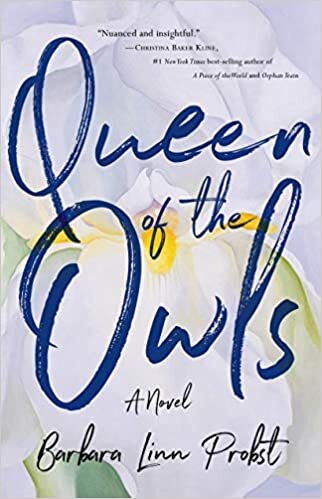 In her first novel, Queen of the Owls, Barbara Linn Probst’s main character, Elizabeth, is not only married to lawyer Ben (whose life has to be planned hour to hour) and the mother of their two children, she is also teaching art history and to earn her PhD, completing research on the paintings of artist, Georgia O’Keefe, the oeuvre O’Keefe completed during a stay in Hawaii.
In her first novel, Queen of the Owls, Barbara Linn Probst’s main character, Elizabeth, is not only married to lawyer Ben (whose life has to be planned hour to hour) and the mother of their two children, she is also teaching art history and to earn her PhD, completing research on the paintings of artist, Georgia O’Keefe, the oeuvre O’Keefe completed during a stay in Hawaii.Throughout the novel, Probst makes definitive references to O’Keefe’s work, a strong aspect of this Women’s Fiction novel, whose focus is the true awakening of a woman’s sexuality. In contrast to the paintings of flowers, their petals, receptacles and stamen, Elizabeth’s sex life is blunted, shaped by duty and sameness. This: “She’d been nudged half-awake by Ben’s erection against her butt.” This sentence pulled me right out of the story, until I realized I needed to understand why Elizabeth would put up with this. No words are exchanged. No kisses to celebrate this relationship: “Elizabeth had trained herself not to watch the calendar too closely because that made it worse. Still, an actual erection…was too precious to waste.” So they have what might be called sex. “Not memorable, but duly accomplished.” DAMN!
The compliant Elizabeth then allows Ben to sleep a little longer, though she’s making his coffee, getting a shower and of course it is she who will be taking care of their two children, Daniel and Katie—making sure she helps them dress and eat, and gets them to the sitter so she is on time for an 8:30 meeting about her PhD dissertation.
TITLE CONFUSION
Is this why Probst has entitled her novel, Queen of the Owls? Another reviewer also asked about the title. An engaging title can lead you into a work, echo engaging themes throughout. Owls might be known for their intelligence; owlish behavior might make us think of Elizabeth in a library, studying the works of Georgia O’Keefe, while her peers are out having a beers in a bar just off campus. Because others have lives, while Elizabeth has chores, one after the other, which she does with purpose and grace. But then: the meeting with Harold Lindstrom, her dissertation advisor.
He zeroes right in, suggesting Elizabeth has not presented and proved a new argument regarding the paintings of O’Keefe. The reader might decide that Elizabeth’s struggles to be a wife and mother are conflicting with her being an OWL, even a queen of the owls, one who stays awake at night, casting her eyes on readings and reprints of O’Keefe’s work. If Elizabeth denies herself free time to do anything but child care and research, she just might succeed in becoming Queen of the Owls.
STORY GOALS
In the novel, Elizabeth does succeed, but only because of an awakening that Probst highlights, a change, a movement in O’Keefe’s work toward beauty and freedom, the power of the female body—metaphors and symbols that Elizabeth begins to experience in her own life, as well as in O’Keefe’s art: “Hawaii itself…lush, fertile, alive. O’Keefe had never seen anything like it…the abundance, the intensity of color and sensation…”
Contrast such feelings that O’Keefe’s paintings arouse in Elizabeth with the sex she recently had with Ben. Probst is building a story, one echoing that of many women, women who fear forging ahead to achieve their goals, who desire to move beyond the infusion of the male ego that comments or complains about EVERYTHING they do.
Thus we experience Elizabeth, arguing her thesis with her advisor: “O’Keefe’s White Bird of Paradise, one of the Hawaii paintings. You never see it listed as one of O’Keefe’s major pieces, but it’s where she brings together, petals and bones, life and death.” And then Lindstrom, the dissertation advisor: “Do you give your husband a hard time too?” A patronizing, dismissive male, one Probst might have created from her own academic experience.
But it is the foil character to husband Ben, to advisor Lindstrom—it is Richard who Elizabeth thinks of at that moment. “She thought of the way Richard had looked at her, in the Tai Chi class…” (Yes, we women are allowed to still look around.)
Then later on, Elizabeth allows herself to ruminate: “Feminist art was supposed to mean art that provoked a dialogue between the viewer and the artwork, rejected the idea of art as static, challenged patriarchal notions of what was beautiful…You saw what you saw, if you looked…O’Keeffe had also said: I feel there is something un explored about women that only a woman can explore.”
Of course. Elizabeth’s eventual research goal, and Probst’s purpose in this novel, is to have the viewer awaken to the power of art, allow Elizabeth to realize the power of the female body, which in this novel she discovers through O’Keefe’s feminist florals, her flowers and stamen, her colors brooding from dark to light. And though many museum viewers stood before those same works talking about genitalia, Elizabeth knew there was something more, something deeper, something more excitingly feminine than a label.
THE SISTER ACT
Contrast is often good for character development. Thus, in the novel, when Elizabeth stops to visit with her only sibling, Andrea, she is reminded of the repeated statement of their mother: Everyone has different gifts. Coming early in the flow of the story, Probst is suggesting that Elizabeth, despite marriage, children, academics, has never truly been certain as to what her gifts are. Or it is because she has seen the flowering of her sister’s business as a hairstylist as something blocking her ability to value her own brilliance, the very different direction her life is taking her.
THE HERO FOR THE HEROINE
And there is Richard, the handsome man in her Tai Chi class, a photographer, who after some discussion is willing to replicate the work of Alfred Stieglitz, this famous photographer who admired O’Keefe and took pictures of her nude. In time, he convinces Elizabeth to actually take her clothes off, so that little by little, she is able to reproduce the poses of a naked O’Keefe, Richard snapping numerous shots, awakening a flowering, a desire for change in Elizabeth. That certainly might be the beginning of her becoming not only an owl, but the queen.
All novels work with contrasts, make the reader wonder what choices the MC will face, the eventual decisions she must make. Elizabeth, at first weighted down: husband, children, teaching, her own sense of needing to achieve, to stand out. But can she do all that, keep husband and family happy while satisfying the desires that O’Keefe’s art and nude photographs have aroused in her? Considering that owls are often quiet during the day, but then rise to great heights at night, filling the night skies with their hoots, drawing attention to what is often referred to as wisdom—in The Queen of Owls Probst must answer all those questions. Read this engaging novel to see if she does.
Facebook Twitter LinkedInPinterest
January 9, 2022
The Lost Book of Eleanor Dare
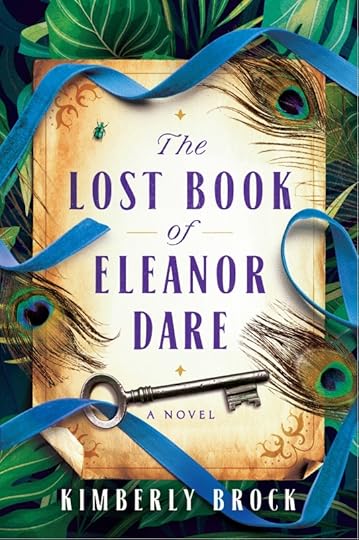 If you have traveled to North Carolina, you may have visited the Museum of History and the exhibit dedicated to Virginia Dare, believed to be the daughter of Eleanor Dare, the first English child born in the New World. This powerful legend and its haunting story of female strength inspired Kimberly Brock’s second novel, THE LOST BOOK OF ELEANOR DARE.
If you have traveled to North Carolina, you may have visited the Museum of History and the exhibit dedicated to Virginia Dare, believed to be the daughter of Eleanor Dare, the first English child born in the New World. This powerful legend and its haunting story of female strength inspired Kimberly Brock’s second novel, THE LOST BOOK OF ELEANOR DARE.
In the 1500s in England, Eleanor White, like others of her sex, inherited her mother’s whispered stories and cherished words that encouraged Eleanor to be more than her mother could be. Though women could do only women’s work and were forbidden new and exciting adventures, they learned to find ways to break rules, their ideas and truths hidden in what came to be known as The Commonplace Book. Even its title masked its contents, for within her deceased mother’s jottings, Eleanor White found hidden messages, secret charms and cures that she could pass on to others of her sex. This was not unlike the anatomy of a women, her necessary and important role in human creation, always having to be hidden under long skirts, cloaks and her silence.
A spark in Eleanor White made her refuse to hide her talent, she becoming her artist father’s apprentice, creating inspired and artful engravings, though only her father’s name could be added to her completed work–Eleanor, a woman, an artist, forced to be invisible. Yet she accepted this, polishing and wearing her deceased mother’s red boots, long grey cloak, and clinging to The Commonplace Book where she copied parables and recipes that helped her accept such a life while creating her own vision of how that life might change, what that life might become.
But in the late 1500’s, when Eleanor’s father is made Governor of a new colony in North America, Sir Walter Raleigh’s Roanoke colony, Eleanor must marry Ananias Dare, a man chosen by her father. He will accompany Eleanor and the newly appointed governor to the New World. At their departure, Eleanor is already pregnant, clasping The Commonplace Book to her breast, drinking her mother’s dark tea recipe, fighting to become her own woman, the one she is meant to be–the progenitor of the line of women who appear in Kimberly Brock’s seductive and beautiful novel. In the words of Penn, the daughter of Alice Young who currently guards The Commonplace Book: We grow and change, we claim our very own world.
FICTION AND HISTORY
Readers of Brock’s novel are in capable hands, this being a tale of mothers who all had daughters, mothers who passed The Commonplace Book from one generation to another, relating the myth of a stone whose engraved words connected all the generations to the historical figure of Eleanor Dare and her female descendants. Brock names them Alice, Bernadette, Claire and yes, Eleanor.
The novel begins with the world in the midst of WW II. Alice Young and her teenage daughter Penn have lost husband and father in the war, and are now driving back to Ever-tell, the home of Alice’s grandmother and mother, supposed descendants of Eleanor Dare.
Alice and Penn have inherited the gentile house on spreading grounds near rivers that feed the Atlantic Ocean. Ever-tell is expansive, with outbuildings, spreading vegetation, wandering peacocks, even a small island. It is a place of lost grandeur and disrepair, yet for Penn it becomes alluring with its hidden stories revealing the lives of people who have lived and are still living there. At a time when Penn craves adventure, yet once thought attending a secondary school was her calling, everything changes. She begins to see that she could be an actual descendant of Eleanor Dare, the pull of Ever-tell, its history, slowly opening her eyes to past worlds, the history of this line of strong women. Impulsively, Penn starts the process of change by inviting the aging lawyer, Oscar Lewallen, to dinner. He concurs that yes, Ever-tell has been passed to Penn’s mother, the 236 acres, a mill, a cemetery on Bell Isle, everything.
Penn’s plan to attend a secondary school fades away. Maybe it is the very ground Penn now walks upon, the people who have lived here for years, the bell that no longer rings and other mysteries of the place that excite her. So much better to fall in love with the history of the females in her family, with all the mysteries connected to them and The Commonplace Book that her mother Alice finds in the dusty and neglected house.
There is Bernadette Reece Telfair, possibly the heir of Eleanor Dare, who completed Ever-tell in 1799, but also found a hand drawn map (so like Eleanor) in the Commonplace Book, with the initials EWD. She sent men to find the source, the beginnings of the lives of Eleanor and her descendants, believing in the stone, one inscribed with the story of the fate of those first adventurers. Verbal history claims the stone was found and brought to Ever-tell to protect it from robbers or the possibility of defacement. But when Bernadette’s daughter Camille disappears, the stone is blamed, Bernadette believing she had brought a curse on the family. Now, where is the stone?
Kimberly Brock has written a novel of strong women, of the struggles of Penn to decide her future: is she being called away from Ever-tell to a different pathway–or should she claim the inheritance before her. She succumbs to the enchantment not only of the physical house and land, but also the history–the missing stone, the damaged bell, wrought by Paul Revere, that Penn believes must ring again.
CHANGE IS ETERNAL
What is so beautifully wrought in this novel are the hearts and souls of women. We don’t need to believe in the myth of Eleanor Dare to become enchanted with their individual stories, their losses and struggles. The explosion that kills a son, and causes the death of an innocent man. The relationships between men and women that have fallen away, because of the darkness of war, because of loss and lies.
Though it provides an historical context, this novel focuses on the sorrows and joys of people connected to the land and buildings that are Ever-tell. The thoughts and words of Penn and her mother Alice underline that the journey is timeless. “I could see the girl I’d been when I’d believed in my own magic,” Alice says. And though she is eager to explore and understand Evertell, she is also conflicted, her husband having been killed in the ongoing war. “I’d gone dark too long ago.” And so had Ever-tell, for on arrival she finds all neglected, not unlike her desire to make a life, to believe once again in her now deceased mother Claire, to help Penn on her path to womanhood. Alice faces much as she slowly discovers the secrets of Ever-tell, realizing that like the bell that needs repair, “she had gone quiet inside.” But watching her daughter embrace a legacy fraught with sorrow and joy, Alice is once again able to open her heart to the legacy of her ancestors, the strength of womanhood, and the love of man who will aid her in claiming the legacy, help her carry the story of her ancestors forward.
From the novel: “Now people live and die in a place, and when you walk the streets, the lawn and orchards, you are walking over lives, over bones—you are tramping on history.”
Facebook Twitter LinkedInPinterest

